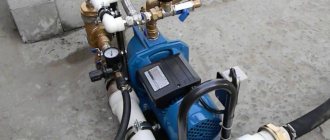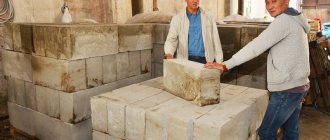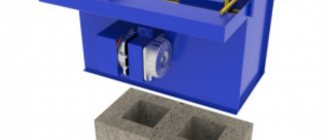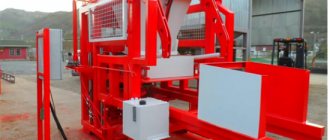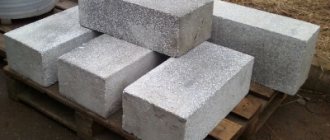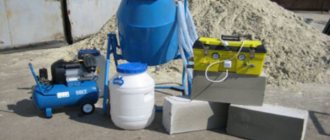In modern individual low-rise construction (buildings, retail space, warehouses, etc.) foam concrete is widely used. This is due to the low price and high performance characteristics of the material (low thermal conductivity, low weight, etc.). In many technical parameters it is better than brick and conventional concrete (reinforced concrete). In addition, foam concrete acts as insulation.
Thanks to the use of new technologies, manufacturers have managed to make this material accessible, because previously it was expensive. Therefore, today houses made of foam concrete can be found in any region of the Russian Federation.
Foam concrete characteristics
The main parameters of foam concrete are given below.
| Parameter | Meaning |
| Thermal conductivity coefficient, W/(m*C) | 0,09-0,38 |
| Density (volume weight), kg/m3 | 400-1200 |
| Brand by density | D400-800, D1000-1200 |
| Concrete compressive strength class | class B 2.5 at D700 |
| Vapor permeability, mg/mhPA | 0,2 |
| Water absorption,% by weight | 10-16 |
| Frost resistance no less | 25 cycles |
| Masonry…/masonry joint thickness, mm | for glue, solution/10mm |
| Average shrinkage of finished masonry, mm/m | 2-3 |
| Possibility of masonry reinforcement | No |
| Average thickness of a single-layer wall, m | 0,63 |
The use of foam blocks allows you to:
- Reduce the cost of construction (no need to buy additional insulation) and maintenance of the facility (foam blocks are not demanding to operate);
- Increase the thermophysical characteristics of the structure;
- Reduce the load on the building's load-bearing structures;
- Quickly build various objects (houses made of foam concrete, garages, sheds, retail space, etc.).
Foam concrete and aerated concrete - do not confuse
On the domestic building materials market today you can purchase two artificial, porous building materials - aerated concrete and foam concrete (according to GOST 25485-89 Cellular concrete. Technical conditions. ). They are similar in composition because they are made using cement, sand, water and a blowing agent. Thanks to the last component, the material obtains a porous structure.
But many do not understand the difference between these materials, because they have many similar parameters. The difference mainly lies in the manufacturing technology of these building materials.
When making aerated concrete, aluminum powder is added to a dry mixture of cement and sand, after which the mixture is mixed well. Next, water is added to it. After which the aluminum powder reacts with the cement, resulting in the release of hydrogen and AL oxides. Hydrogen fills the concrete mixture with bubbles, the structure of which becomes cellular (bubbles can be large - 3 mm or more or small - 1 mm or less).
With low quality material, it has a non-uniform structure in height, which is reflected in many of its parameters. High-quality aerated concrete has a uniform structure and improved characteristics.
How to do it yourself?
Since the technological process of creating foam blocks is simple, some experienced builders create installations on their own to use them on construction sites and not purchase material. This saves them a considerable amount. Some elements are easier to buy ready-made, others are made locally.
How does the process of creating foam blocks go:
- Prepare a mixture of cement, sand, water, and add a foamed substance.
- The mixture is stirred until a homogeneous mass is obtained.
- Pour the mixture into molds and leave until completely hardened.
What tools and equipment will be required?
For foam concentrate:
- sealed container;
- valve 2 pcs adjusting, 3 pcs;
- compressor (it can be replaced by an ordinary vacuum cleaner);
- mesh with small holes;
- pipe for supplying the mixture;
- air supply pipe;
- flexible pipe 2 pcs;
- Laval nozzle or jet.
Purchase a concrete mixer separately (special, with gentle rotation).
For forms:
- sheets of metal;
- connecting brackets;
- welding machine.
Step by step creation process
The first thing to prepare is a tank for mixing the foaming agent. Any, preferably metal, cylindrical container is suitable for this (an empty gas cylinder is often used).
Creating a camera:
- A pipe with a pump is welded to the cylinder on one side to discharge the mixture into the foam generator.
- A flexible pipe is connected to the other to load the mixture into the chamber.
- A flexible pipe is installed nearby to supply compressed air from the compressor to the chamber. A valve is installed at the connection point to regulate the pressure.
Creating a foam generator:
- Weld 2 pipes to the pipe. The first is from the end, the second is approximately in the middle at an angle of 90 degrees.
- Valves are attached to the outlet openings of the pipes for subsequent adjustment of the flow.
- Weld a pipe to the end of the second pipe - this is the outlet part of the structure. Install a funnel inside the nozzle so that the foam flow rate at the outlet is reduced.
- A mesh is placed inside the second pipe; a ready-made filter can be used. It must be compacted along the entire length of the pipe.
- Connect the two pipes so that the end pipes are on opposite sides. Install a nozzle in the middle; it will reduce the flow rate of the mixture.
Connection of chamber and foam generator:
- Using a hose, the outlet pipe with the chamber pump is connected to the side pipe of the foam generator.
- The compressor is connected by a hose to the end pipe of the foam generator.
- The outlet pipe of the foam generator is connected to the concrete mixer.
Making molds:
- There are two options: solid forms and collapsible. For solid ones, you will need a bottom onto which the plates are welded into even cells of the required size.
- For a collapsible form, long metal sheets are cut crosswise so that some are inserted into others perpendicularly and form even cells.
- Side panels are attached to the bottom along the perimeter. They are connected with clamps on the sides, and can be looped on the lower edge.
Foam concrete is poured into molds so that the sheets remain a few centimeters free. After hardening, the clamps are removed, the side panels are tilted, the metal plates are pulled out from each other, and the foam blocks become free.
Video review of a do-it-yourself foam block production installation:
Foam block production technology
Fill the concrete mixer with sand, Portland cement and water in the required proportions. The apparatus is started, after which it is expected that a homogeneous mixture will be obtained. Next, the foam is prepared in a foam generator, after which it is added to the mixture, and then the required amount of hardener is poured into the solution. Next, the solution is stirred again for 3–4 minutes. With longer mixing, the foam will collapse, and the strength and other characteristics of foam concrete will decrease.
After preparing the solution, it is filled into molds prepared in advance (wooden ones are moistened with water, and iron ones with machine oil or waste). After filling out the forms, the poured blocks are left to harden for a day (sometimes you have to wait longer). Concrete must gain strength at an air temperature of 6C or more. If work is carried out in a cold workshop in winter, then it must be warmed up using a heater or a heat gun. After a day, the finished foam blocks are removed from the molds and placed on pallets.
It should be borne in mind that the better the hardener used, the faster the foam blocks harden.
In general, the entire procedure for making foam blocks takes no more than 2 days. To competently organize the technological process and increase its productivity, the following is required:
- Use water heated to 30C to mix the solution.
- To accelerate the hardening of foam concrete, calcium chloride must be added to it (≈1.5% of the total mass of the mixture). In addition, this will reduce the likelihood of block cracking. The additive must be used when performing work in winter.
- If you regularly fill foam blocks, it is better to make steaming chambers for drying foam blocks at 60C. This will reduce the production time of products.
- Use forms with cells whose dimensions comply with GOST standards.
- Wood molds must be covered with polyethylene after filling, and iron molds must be lubricated with machine oil (working off) before use.
Do it yourself
In order to produce all the necessary devices for creating foam blocks, you should study the production process in detail, and based on it, select the necessary units. It should be borne in mind that not all elements should be made independently, since certain parts are easier to buy ready-made. It will be much faster and cheaper.
Ready-made foam intended for mixing with cement mortar
Manufacturing process
Typically, equipment for cutting foam blocks is only needed during installation, since this building material is produced in special forms.
- First you need to prepare the mixture. It is made from sand, cement, water and a special foam substance.
- First, a cement mortar is created, which is prepared in the proportion indicated on the instructions to the foaming agent.
- Next, the purchased composition is diluted with water in a foaming agent and the finished foam is added to the solution.
- After this, it is necessary to stir the resulting mixture for a few more minutes until a homogeneous mass is obtained.
- As a result, the resulting mixture is poured into molds and allowed to harden.
It is worth noting that foam blocks and equipment for their production may have different technical characteristics, so the description of production is given approximate in order to understand its basics.
Mold design
Form
It is best to make this piece of equipment yourself.
In this case, you can set any dimensions for future products or give them a specific shape.
- For manufacturing, it is best to use sheets of metal, since other materials wear out very quickly.
- From these, a foam block mold is welded into several cells, each of which corresponds to a block.
- It is worth remembering that the welds must be located outside so that the finished product can be removed without interference.
- It is worth noting that if used equipment for foam blocks is sold, then the form made of metal will be the most efficient part, which will retain all its original qualities.
A small concrete mixer will become an indispensable tool for a professional builder, especially when creating foam blocks
- Forms for foam blocks
- Equipment for the production of foam blocks
- How foam blocks are made
Mixer
To create this unit, you may need a lot of different devices, the price of which is quite high. That is why craftsmen recommend using a regular concrete mixer as a replacement. It is worth noting that it is useful not only for the manufacture of blocks, but also for their subsequent installation.
The mixer can also be replaced with a container into which a drill with a special mixer attachment is installed. However, the performance and quality of such a device leaves much to be desired.
Amateur photo of the finished foam concentrate
Foaming agent
This piece of equipment is one of the main ones, since it is what is used to create foam. Therefore, many craftsmen prefer to purchase it in a store rather than do it themselves.
In fact, creating such a device is quite simple:
- First you will need a large and sealed container in the form of a barrel.
- You will need to load water and a foaming agent into it.
- After this, a compressor is connected to the bottom of the container, and an outlet is made in the upper area.
- In this case, a valve is installed at the air inlet into the barrel, which will regulate the flow of the substance.
- The outlet is also connected to the compressor through a tee, on the air supply side of which a valve is also mounted.
- The result is a system with two valves that regulate the amount of oxygen and liquid at the outlet.
- Next, the instructions for producing a foam block require that the finished mixture pass through a grid with small holes, as a result of which foam is formed. Therefore, a special nozzle is installed at the outlet of the tee. It can be used as a car muffler with a grille or cellular material installed in it.
The principle of operation of the foam concentrate
Equipment for the production of foam blocks at home
To produce foam concrete, the following equipment is required:
- Concrete mixer. It is permitted to use an installation for the production of cellular concrete for these purposes;
- Compressor. Necessary for pumping air into the steam generator and mixer;
- Foam generator. Allows you to prepare foam;
- Form. It is often made independently from wood or iron.
If you plan to make foam blocks year-round, you will need to additionally buy a steamer in addition to the equipment listed above. You can also assemble the installation yourself, but this will not save much money. Moreover, some elements may not fit together well, which will affect the quality of the foam blocks.
It is better to buy equipment as a set, which costs between 100,000 and 250,000 rubles. This installation will make it possible to produce 10-25 m3 of foam concrete per work shift.
When selecting equipment, you need to pay special attention to the power and characteristics of the electric drive. In addition, you need to consider the distance to which the finished solution can be supplied.
If you are building your own house and you need the equipment one-time, then it is better to rent it.
While using the equipment, it must be washed periodically.
Types of installations
The foam block production business is considered one of the fastest to pay back. The cost of production, among other things, includes equipment costs. Its choice must be approached with all responsibility; existing varieties differ in productivity and quality of the resulting product.
Mobile
This type of equipment can be purchased in parts or as a complete set. The ready-made option is preferable, it is easier to work with and can be put into operation faster. The mobile unit consists of the following parts:
- Vibrating screen. Sifts raw materials and removes debris.
- Device for feeding raw materials. Transfers sand and cement to the main compartment.
- Water dispenser.
- Mixer.
- Bar mixer (rarely a foam generator).
- Compressor.
- Hose. Outputs the finished material.
Pros of mobile installations:
- simplicity and ease of use;
- inexpensive maintenance;
- low cost;
- there are no parts operating under pressure (which means a license to produce the material is not required);
- relatively light weight design, can be moved if necessary.
Minuses
- the foaming agent is quickly consumed;
- the blocks are less durable than those created using more professional equipment.
Production of a mobile unit: 24-72 cubic meters/day.
What cars are in demand:
- Sunny from Stroy Beton.
- Metem from Metem Group.
- Robus 500MS from the ROBUS Enterprise.
For those who are not going to open a factory or a large workshop for creating foam concrete, you can choose used installations, which will be several times cheaper in price.
Video review of the mobile installation for the production of foam blocks "BAS-130":
Stationary
The units have a more serious design, which is why their price may seem high.
Components:
- concrete mixer;
- foam generator;
- concrete supply means;
- molds for the finished product;
- equipment for curing foam blocks;
- cutting machine.
Advantages:
- productivity is significantly higher;
- the quality of the finished product is better;
- foam concentrate consumption is lower;
- the cost of foam blocks is lower.
Disadvantages: high cost of equipment.
Stationary installations require a spacious room. Used for mass production of foam concrete. Average productivity is 40-100 cubic meters/day.
There is a ready-made single structure or a prefabricated one. Before purchasing, you need to select and prepare a room for setting up a production workshop (if such work has never been carried out there before).
There are several important conditions:
- minimizing manual labor (positively affects the quality of the finished product);
- placement of equipment should be as compact as possible, without large distances between parts of the installation;
- access of water to the workshop must occur without interruption;
- presence of a crane beam;
- separate place for the steaming chamber;
- the aging equipment has a secluded place, dry and draft-free.
A popular brand of stationary installations is Metem from Metem Group.
Before ordering equipment, you need to draw up a floor plan and decide on placement in specific conditions. A license will be required.
Automatic
High-quality equipment used in factories for the production of foam blocks. The participation of manual labor is minimized, the quality of the finished product is significantly better. Organization of automatic production requires preparation:
- availability of a cement warehouse with a dosing system;
- creation of sand storage;
- space for a component distribution line for their subsequent transfer to equipment;
- area for production line;
- area where finished foam blocks are cut and stored.
Advantages:
- highest productivity;
- the process is fully automated, minimum labor required;
- automation allows you to reduce the cost of finished products, sales increase.
Flaws:
- high cost of equipment;
- the need for large areas for installation.
Organizing automatic production will require considerable expenses at the first stage; at best, they will pay off within a year.
What equipment is popular:
- Fomm-PUSK from Stroy-Beton.
- FC100WM from NPK FCI Technologies.
- Start (semi-automatic) and Metem-AZP from Metem Group of Companies.
Preparation of foam concrete mixture
Making foam concrete with your own hands at home is quite simple, you just need to have the above equipment and the materials specified below.
Foam concrete is made from:
- Cement;
- Water;
- Sand;
- Foaming agent;
- Additives Improves the properties of the material. To increase frost resistance, the BIO-NM modifier is added to it. To increase air entrainment, aerating additives BIO-Lux, Siplast or PVD-3 are added.
To produce 1 m3 of high-quality foam concrete (density 600 kg/m3), you need to use the following quantities of materials:
- sand – 200 kg;
- cement – 320 kg;
- hardener - in accordance with the manufacturer's instructions;
- foaming agent – 1.2–1.5 l;
- water - 100–110 l.
The lower table shows the composition of foam concrete of some brands.
| Composition of foam concrete mixture per cubic meter | |||||
| Foam concrete brand | Amount of cement M500 (kg) | Quantity of sand (kg) | Amount of water (l) | Foaming agent quantity (kg) | |
| Foam formation | Obtaining a solution | ||||
| D600 | 310 | 210 | 55 | 110 | 1,5-2,0 |
| D800 | 320 | 420 | 45 | 120 | 1,2-1,5 |
| D1000 | 350 | 590 | 40 | 140 | 0,8-1,2 |
Business Features
There are two fundamentally different approaches to the production of foam blocks. In the first case we are talking about the so-called. a handicraft workshop designed to provide building materials to the manufacturer himself and, in extreme cases, a small number of his acquaintances. We will not consider this option, since the technology used does not allow us to produce products of a quality acceptable for mass consumption. This means that the enterprise will not be viable in the future. On the other hand, no one bothers you to make the required number of blocks yourself for building a garage, gazebo or country house - a minimum of equipment and funds will be required.
If you plan to create an enterprise aimed at making a profit, you should prepare for serious investments. But first of all, it is necessary to work out the technology for producing foam blocks. Despite its apparent simplicity, the technological cycle has a lot of subtleties that existing manufacturers are in no hurry to share. Therefore, you will have to hire a specialist who will help in choosing equipment, purchasing raw materials, selecting the optimal recipe and keeping the production process under control.
The next pitfall is logistics. The cost of blocks is directly related to the delivery distance of raw materials and finished products. This means that the closer the component supplier’s warehouses and the facilities where the finished foam blocks will be shipped are located, the better conditions the entrepreneur can offer to customers.
Demand is also subject to fluctuations. On the one hand, it is influenced by the intensity of construction in the region. On the other hand, seasonality. In winter, the activity of developers decreases. However, having begun preparations for the opening of production in the fall, you can count on your first customers in the spring. Especially if the entrepreneur takes care of establishing contacts with wholesale buyers in advance.
Foam concrete is produced using the following technologies:
Two-stage (using a foaming agent)
In addition to the low-speed mixer, this line includes a foam generator, which allows you to properly prepare the foam agent. After filling the mixer with foam, the remaining concrete components are poured into it, after which it is all thoroughly mixed at a mixer rotation speed of 25 rpm.
After preparing the solution, it is fed through pipelines into molds.
It is necessary to note the advantages of this technology:
Pores are formed through a controlled process, which allows products to be made with the required density and thermal conductivity. The material turns out fine-meshed. Due to forced foaming, the quality of foam concrete increases.
The disadvantages include:
Higher price of equipment. The high cost of the foam block because a foaming agent is required. There are fewer possibilities in the process of supplying the mixture through pipelines, especially vertically.
Dry mineralization method
In this case, air cells in the solution are formed due to physical processes, and not with the help of a foaming agent. But such work is very responsible, since you have to use high-pressure containers.
The main element of the installation for the production of foam concrete is a pressure unit, which is made in the form of a mixer for dry mixing of materials, but it operates at high speeds (420 rpm). Thanks to the high rotation speed, the solution is mixed and mixed under high pressure. As a result, air bubbles do not “open”, but their shape, size and quantity are retained. Therefore, the finished material has an even porous structure.
In addition, dry mineralization allows the solution to be supplied through a pipeline to a height of 10 -30 m. This technology is low-cost because the equipment is not expensive.
Most often this method is used in continuous production. It makes it possible to produce very durable foam concrete, but it has worse thermal conductivity characteristics.
Implementation
The production of foam blocks as a business involves a close connection between the production and sales of products. If the entrepreneur cannot quickly sell fairly large volumes of products, the plant will operate at half capacity and will not bring the expected profit.
Solving this problem is easier than it seems. A typical house construction team lays 6–8 m³ of foam blocks per day. Accordingly, a businessman needs to find only three or four similar customers to provide the workshop with work. How to look for clients:
- If the production base is located near a busy road, you can install a billboard or banner with a sign on the side of the road.
- In areas of new buildings, dacha cooperatives and cottage villages, it is advisable to post leaflets offering the product.
- You can advertise in specialized publications and newspapers, which are found in almost every city.
- Construction companies and teams must be called personally, having previously prepared an interesting presentation of the products.
- You also need to personally negotiate with the owners of construction stores and supermarkets, wholesale centers and specialized markets.
- On the Internet, first of all, you should place offers on trading platforms and portals, message boards and resources for builders.
- At a minimum, a simple one-page website with a list of products, contacts and an order form is definitely needed for a mini production of foam blocks.
- Potential clients can be met on various construction forums and in social networking groups. Here you need to start not with advertising, but with communication.
- To attract traffic from search engines, you need to optimize your site for key queries and publish contextual advertising.
- Finally, an entrepreneur can organize retail sales of products through his own store, located directly next to the foam block production plant.
Production of foam concrete using a foam generator
Producing foam concrete using a foam generator is not a complicated process. First, mix the mixture in advance, then soak it in water (observing the proportions). Then the liquid solution is fed under pressure into a foam generator, where it foams. As for the proportion of foam concentrate in relation to concrete, it varies between 0.5-1.5 kg per 1 m3. You should always do one filling per 4-6 m3 of concrete.
Molding foam blocks
Today injection molding and cutting molding are used.
The first method involves pouring foam concrete into cellular forms, which you buy or make yourself. Thanks to this, this method is considered the most accessible. In construction, foam blocks of different sizes are sometimes required, so you need to prepare forms with cells of the required sizes in advance. When cast blocks are removed from their molds, the edges are often damaged.
In the second case, a large formwork is filled with a liquid solution, which is removed after the solution has hardened. Next, a large piece of foam concrete is cut into small blocks using a special installation, which contains cutting strings, tapes or saws. This allows us to produce more even blocks of the required size, and they never chip.
The disadvantage of this method is cutting, since this is a rather complex and labor-intensive process that requires some experience.
Foam blocks: sizes, pros and cons for building a house
The table below shows the block sizes.
| Block sizes, mm | Weight depending on the type of foam concrete, kg | |||||||||
| D300 | D400 | D500 | D600 | D700 | D800 | D900 | D1000 | D1100 | D1200 | |
| Wall foam blocks | ||||||||||
| 200x300x600 | 11,7 | 15,6 | 19.4 | 23.3 | 27.2 | 31.7 | 35.6 | 39.6 | 43.6 | 47.5 |
| Partition blocks | ||||||||||
| 100x300x600 | 5,8 | 7,8 | 9,7 | 11,7 | 13,6 | 15,8 | 17,8 | 19,8 | 21,8 | 23,8 |
The table shows that each brand of block differs in weight.
They also produce large-format products, but to work with them you need lifting equipment. But thanks to them, it is possible to speed up any construction. Large-format foam concrete blocks have the following dimensions:
- 1000x600x600 mm;
- 1000x600x500 mm;
- 1000x600x400 mm;
- 1000x600x300 mm.
They also make small-format blocks, used mainly for insulation, and less often for the construction of thin walls in places where it is necessary. Such foam concrete blocks have the following dimensions:
- 600x300x100 mm;
- 600x300x150 mm.
Advantages and disadvantages
Foam block has the following advantages:
- Inexpensive (brick costs more);
- Has high thermal insulation parameters.
- Thermal conductivity of foam concrete is 0.08-0.20 W/mS. This characteristic makes it possible to reduce the heat loss of the building by 30% compared to a brick building;
- Easy to process and install;
- It weighs little, so the load on supporting structures is less; Allows you to make a variety of attractive architectural elements: arches, columns or portals;
- It is a non-flammable material;
- Long lasting. The service life of a structure built from foam blocks is at least 35 years;
- Ecologically pure. Foam blocks are made from natural materials, so they do not rot, and fungus or mold does not appear on them;
- It has high sound-absorbing characteristics, which will protect the living space from any external sources of noise.
Disadvantages of the material:
- Low strength;
- Absorbs moisture;
- Large shrinkage.



